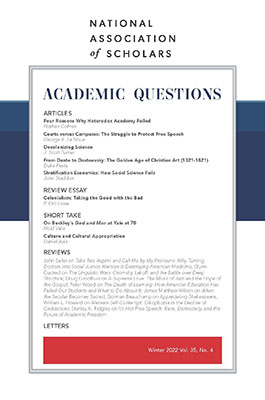Take Two Aspirin and Call Me by My Pronouns: Why Turning Doctors into Social Justice Warriors is Destroying American Medicine, Stanley Goldfarb, 2022, Bombardier, pp. 216, $17.00 paperback.
John Sailer is a Senior Fellow at the National Association of Scholars; [email protected].
Last year, the Oregon Health and Science University (OHSU) School of Medicine released its Diversity, Equity, Inclusion, and Anti-Racism Strategic Action Plan, a 24-page document that lists dozens of “tactics” for fostering “social justice.” One tactic reads like a warning to dissenters: “Include a section in promotion packages where faculty members report on the ways they are contributing to improving DEI, anti-racism and social justice. Reinforce the importance of these efforts by establishing clear consequences and influences on promotion packages.” Medical education is to no one’s mind a bastion of Marcuse’s repressive tolerance. Yet, perhaps more than any other discipline, medicine has embraced the diversity, equity, and inclusion (DEI) revolution most thoroughly, as the OHSU plan illustrates in its clumsy bureaucratic prose.
If anyone can unpack this unlikely trajectory, it would be Stanley Goldfarb. A former professor and associate dean at the University of Pennsylvania School of Medicine, Goldfarb witnessed the transformation firsthand at Penn. His 2019 Wall Street Journal op-ed, “Take Two Aspirin and Call Me By My Pronoun,” elicited vehement condemnation from politically active medical school professors, students, and administrators. As Goldfarb notes in his new book, which borrows the op-ed’s title, this zealous response proves his point—namely, that medical schools have embraced activism to the detriment of sound education.
Throughout the book, Goldfarb provides no shortage of examples arguing repeatedly that “woke” medical education diverts from teaching, pushes doctors into misbegotten political advocacy, and erodes standards. “Not only has there been a decline in the standards used for admission,” he notes, “but there has also been an ongoing failure to hold students to consistent standards during medical school.” The same goes for premedical education: “The premedical curriculum is now being infected by the notion that a rigorous approach to medical education is as obsolete as the ideal of the physician as a highly trained clinical scientist.” This is the predictable side-effect of an obsession with social justice.
Early on, he points to White Coats 4 Black Lives (WC4BL) as a salient example, an activist organization that boasts chapters in over seventy medical schools. Goldfarb quotes WC4BL’s vision statement, which calls for “dismantling dominant, exploitative systems in the United States, which are largely reliant on anti-Black racism, colonialism, cisheteropatriarchy, white supremacy, and capitalism.” To his point, the group also attacks medical standards, decrying the United States Medical Licensing Examination as “discriminatory.”
Goldfarb understates WC4BL's influence. In 2020, many of its chapters successfully elicited DEI plans at places like UNC-Chapel Hill and Columbia University, earning not just the acquiescence but the praise of administrators. At some schools, administrators even invited WC4BL members to help develop new DEI policies.
DEI policies often create vicious cycles, whereby more DEI policies are eventually demanded. Goldfarb convincingly describes abuses in medical research, which can easily be the result of policies that call for “health equity” research. In study after study alleging racial bias, he exposes the methodological limitations routinely ignored by an eager media. One study in the Proceedings of the National Academy of Sciences suggested that black babies are much more likely to live if they have black doctors.
At times Goldfarb falls into what can only be described as snark. “Stop, please. This is malpractice.” “Let’s face it. There is no satisfying these people.” “The idea that this parameter in any way reflects racism is idiotic.” The tone is distracting, though one can hardly blame him. Not only did he witness the ideological takeover of medicine firsthand; his career as a professor was disrupted by it. Following his Wall Street Journal op-ed, Goldfarb faced intense professional scrutiny. “Penn administrators debated whether my opinions had disqualified me from teaching,” he notes. Thus, only a short time after he finished serving as associate dean of curriculum, he found himself “monitored for deviations from the party line” while teaching.
But why has medical education been so thoroughly overtaken? Goldfarb leaves readers eager to learn more about the top-down forces that brought all of this about. OHSU’s DEI plan—the one that promises “consequences” for dissenters—notes that it was created in alignment with accreditation requirements. Some argue that the contemporary obsession with narrow identity categories arose from civil rights law, an ultimate top-down force. Goldfarb ends with a call for restoration: “We should insist that merit be rewarded in medical school as it was not too long ago.” This call warrants more thorough inquiry. Without knowing how we got here it is impossible to know how to return.
Photo by Owen Beard on Unsplash













